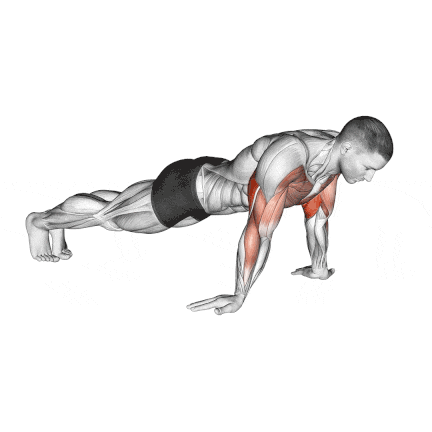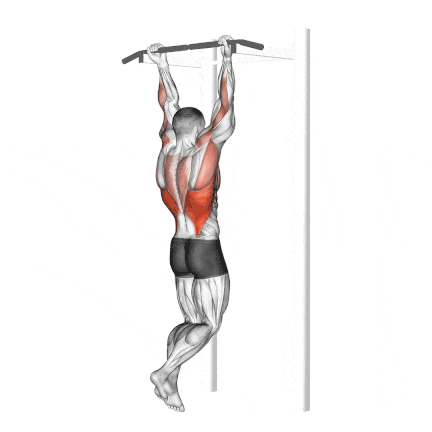When training the biceps, most people immediately think of dumbbell curls or barbell exercises. However, push-ups are a highly effective and often overlooked exercise that can target and develop your biceps right at home.
Yes, push-ups aren’t just for the chest and triceps—when done correctly, they can also engage and challenge your biceps, leading to increased strength and impressive arm definition.
Push-ups are one of the greatest general conditioning exercises for outdoor athletes. They can be done anywhere, and no equipment is required.
Some modifications are required to work the biceps effectively during push-ups. One approach is to rotate the hands in the opposite direction or bring them closer together. These changes put the biceps in a better position to contract and engage more easily.
Check out all other push-up variations to train the bicep.
Know More: Bodyweight Biceps Exercises at Home to Bigger Arm

3 Best Push-Ups For Biceps
Here are the different types of push-ups that target the biceps: reverse-grip push-ups, archer push-ups, and close-grip push-ups.
1. Reverse Grip Push-Ups
The reverse grip push-up is a fun and great variation of the standard push-up. You do it with your fingers facing your feet (your palms outward).
It is also known as the “bicep push-up” because its hand position emphasizes the biceps slightly more than the standard push-up.
You can do the reverse grip Push-Ups on the knee or an inclined surface for an easier variation.

How to do
- Start in a standard push-up position. Place your hands slightly wider than your shoulders, palms flat on the floor, and fingers pointing towards your feet.
- Inhale and slowly start to bend your elbows.
- Do not let your elbows move outwards (away from your body).
- Lower yourself until you are about an inch from the floor.
- Pause the movement when you are at the bottom for a second.
- Exhale and start pushing your body back up. Push through your palms like you would try to push the floor away from yourself.
- Finish the exercise by extending your arms completely out. Repeat this for however many repetitions you wish to perform.
Tips
- If your wrists are not mobile enough, this push-up variation can hurt them. Before exercise, use wrist straps or do the same on an inclined surface.
- Always warm up properly, especially by focusing on warming up and stretching your wrists.
2. Archer Push-Up
Archer Push-Ups are an advanced variation of the push-up exercise that not only engage the chest, triceps, and shoulders but also target the biceps
In Archer push-ups, the arms are kept wider than in the normal push-up position. As you lower your body, you transfer most of your weight to one of your hands and incline towards that hand, while the other is kept straight.
It also challenges the core muscles to maintain stability during the asymmetrical movement.

How to do Archer Push-Ups
- Start in a standard push-up position with your hands slightly wider than shoulder-width apart and elbows completely locked out.
- Maintain a strong core position and shift your upper body toward your right side. Make sure your body is in a straight line from head to feet.
- Pull your right chest toward your right hand as you bend your right elbow.
- As you lower toward the right side, allow your left arm to straighten.
- Your left arm should be fully extended, forming a straight line from your shoulder to your hand.
- Repeat for your desired number of repetitions, switch sides.
3. One-arm Push-up
A one-arm push-up is a compound exercise that requires far more strength and balance than a standard push-up.
The one-arm push-up might be one of the most difficult body-weight exercises to master. Almost 70 percent of your body weight is bearing down on one arm.
It requires great pushing strength, core stability, and total body control.

How to do
- Get in the standard push-up position with feet wider than shoulder-width apart.
- Place one hand on the ground directly beneath your chest and the other behind your lower back.
- Straighten your legs behind you, spread them wide, and point your toes into the ground.
- To maintain balance, turn your torso slightly away from the pushing arm.
- Breathe as you lower your angled torso to the ground until your chin is a few inches above the floor.
- Breathe out as you push yourself up from the floor, keeping your back straight.
- Stop just before you lock out your elbow at the top of the movement.
Combine Bodyweight Bicep Exercises With Push Up
Even if you are curious about doing bicep push-ups, you might lack the core, arm, pecs strength to actually perform them. No need to be ashamed of this, though, as push-ups require a lot of strength to do, let alone an even more challenging variation.
Here are some of the best exercises you can perform at home.
1. Bodyweight Bicep Curl
The bodyweight bicep curl is a very effective bodyweight isolation exercise for building Bicep size and strength.
Sometimes, we don’t have access to equipment, but that’s not an issue with the bicep leg curl, as you only need your arms and legs.

2. Inverted Row
The inverted row is another name for bodyweight rows. It’s also known as an Australian pull-up. The inverted row puts your body horizontally, making it easier to perform.
But, you can also perform the inverted row at home by lying under a chair, holding the chair’s sides, and pulling yourself up.

3. Chin Up
Chin-ups are an effective compound exercise that engages multiple muscle groups in the upper body, including the back, biceps, and shoulders, promoting overall upper-body strength.
A chin-up is an exercise in which the palms face toward the body while gripping the bar (underhand or supinated grip).
The underhand grip used in chin-ups places greater emphasis on the biceps, assisting in bicep muscle activation and growth.

FAQs
Does the Regular Push-Up Work Biceps?
The regular push-up primarily targets the chest, triceps, and shoulders. While the biceps are somewhat involved, their engagement is primarily static or isometric. This means regular push-ups alone are not optimal for targeting and stimulating significant bicep growth.
Push-ups are generally not recommended for training the biceps because they are ‘push’ exercises, while the biceps are ‘pull’ muscles.
There are many great bodyweight ‘pull’ exercises that train the biceps, including pull-ups, chin-ups, inverted rows and inverted curls.
I would like to point out that bicep push-ups will never be as effective on your biceps as pull-ups, chin-ups, or inverted rows. Should you still want to do bicep push-ups? Then, try the variations shown above.
Do diamond push-ups work triceps or biceps?
Diamond push-ups primarily target the triceps muscles. This hand position places greater emphasis on the triceps, which makes them work harder during the exercise. The biceps are involved somewhat during diamond push-ups, but their involvement is secondary compared to the triceps.
Takeaways
The push-up builds upper-body and core strength. It can be modified in many ways; beginners can start with easier versions, while more advanced exercisers can use a challenging variation.
Pushups are a fast and effective exercise for building strength. They can be done from virtually anywhere and don’t require any equipment.
Doing variations of them — to hit the biceps, for instance — will spice things up and target different muscles.
References
- Exercise library: Push-up. (n.d.). acefitness.org/education-and-resources/lifestyle/exercise-library/41/push-up
- cogley, robert m.; archambault, teasha: a comparison of muscle activation using various hand positions during the push-up exercise. journal of strength and conditioning research 19(3):p 628-633, august 2005.
- Kleiber, T., Kunz, L., & Disselhorst-Klug, C. (2015). Muscular coordination of biceps brachii and brachioradialis in elbow flexion with respect to hand position. Frontiers in physiology, 6, 215.
- Tiwana MS, et al. (2018). Anatomy, shoulder and upper limb, biceps muscle. ncbi.nlm.nih.gov/books/NBK519538/

Manish is a NASM-certified fitness and nutrition coach with over 10 years of experience in weight lifting and fat loss fitness coaching. He specializes in gym-based training and has a lot of knowledge about exercise, lifting technique, biomechanics, and more.
Through “Fit Life Regime,” he generously shares the insights he’s gained over a decade in the field. His goal is to equip others with the knowledge to start their own fitness journey.

